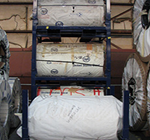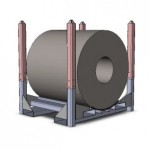Tips for Rack Safety and Keeping OSHA Away
Storage racks are the most important storage solutions in an industrial manufacturing facility, as well as warehouses. They are also used in various another commercial, residential, and retail applications. Although most users know about the importance of rack safety, still it is one of the most overlooked areas. In this post, we will discuss tips for rack safety, and how to keep Occupational Safety and Health Administration (OSHA) away.
Introduction to OSHA Regulations – OSHA 1910 Standards
The OSHA is a federal agency that regulates safety and health legislation in the US. The following are some important storage rack regulations promoted by OSHA:
- 1910. 176 (b): This regulation deals with the safety of the stored items. It doesn’t address any racking in particular, but discusses safe stacking requirements. It regulates the importance of keeping materials safe, and avoiding their collapse or falling at slightest disturbances. (Read about all the Materials Handling and Storage Regulations by OSHA)
- 1910.159: This regulates the height of storage to fire sprinklers. However, it requires 18- inch clearance to achieve it. (Read about all the Fire Protection Regulations by OSHA)
Introduction to General Duty Clause
However, most racking issues are covered under the General Duty clause of OSHA. It creates awareness among employers to secure lives of their workers by regulating installation, and maintenance instructions. Three racking issues are cited under this type of clause:
- Rack Columns with Insufficient Support: The clause stipulates that rack columns should be supported with column base plates, and anchored to the floor with durable anchor bolts. These bolts should be capable of resisting the load.
- Racks without Load Ratings: This clause mandates employers to mention minimum and maximum permissible loads, and maximum uniform load distribution per level, or maximum total load at each bay.
- Improper Rack Maintenance: Improper rack maintenance leads to damage, and OSHA requires employers to develop an efficient maintenance program. This program should clearly define clearance, alignment, level, and plum, as per the manufacturer’s instructions, and educating employees to identify the damage, and report them.
Key Considerations of OSHA Fall Protection Standard 1910
Fall protection is a critical component of workplace safety, especially in environments where employees work at heights, such as on storage racks or elevated platforms. OSHA’s Fall Protection Standard under 1910.28 outlines the requirements for protecting employees from fall hazards in general industry workplaces. Compliance with this standard is essential to prevent serious injuries or fatalities.
Here are the key considerations of OSHA Fall Protection Standard 1910:
Height Thresholds for Fall Protection: OSHA mandates that fall protection must be provided at elevations of 4 feet in general industry workplaces, 5 feet in shipyards, 6 feet in the construction industry, and 8 feet in longshoring operations. This means that if employees are working at or above these heights, appropriate fall protection measures must be in place.
Guardrail Systems: One of the primary methods of fall protection is the use of guardrail systems. These must be installed along any open sides or edges where there is a risk of falling. Guardrails must be capable of withstanding a force of at least 200 pounds, applied within 2 inches of the top edge in any outward or downward direction.
Safety Nets and Personal Fall Arrest Systems (PFAS): Where guardrails are not feasible, employers can use safety nets or personal fall arrest systems (PFAS). Safety nets should be installed as close as possible beneath the walking/working surface but not more than 30 feet below it. PFAS, which includes harnesses, lanyards, and anchor points, must be properly maintained and inspected before each use.
Ladder Safety: When ladders are used for accessing or working on elevated storage racks, they must be used correctly to prevent falls. Fixed ladders over 24 feet must be equipped with ladder safety or personal fall arrest systems. Portable ladders must be stable and positioned on a firm surface.
Training and Education: Employees working at heights must be trained on the proper use of fall protection equipment, recognizing fall hazards, and the procedures to follow in case of a fall. This training should be refreshed periodically and whenever there are changes to the workplace or the type of fall protection equipment used.
Inspection and Maintenance: Regular inspection and maintenance of fall protection equipment are crucial to ensure its effectiveness. Employers must establish a routine inspection schedule and replace any damaged or worn-out components immediately.
Documentation and Compliance: Employers must keep detailed records of fall protection measures, including training sessions, inspections, and any incidents of falls or near misses. This documentation is not only vital for OSHA compliance but also helps in identifying areas where fall protection strategies can be improved.
Tips for Building OSHA Friendly Storage Racks
If you are a business, which is concerned about the welfare of your employees, the following rack safety checklist will help you meet your purpose, and keep OSHA away:
- When buying racks ensure they are equipped with features that assure protection and durability.
- Ensure the floors and walls supporting these racks have good structure integrity.
- Install racks as per the manufacturer’s instructions.
- The racks should be built up such that there is adequate clearing space between pallets and frames, between pallets and underside of beams, pallet overhang, forklift operations, and have easy access to the door.
- The base plate should provide sufficient anchorage and should be strong enough to support the column or profile placed on it.
Once, the above-mentioned steps are followed, you need to ensure the following:
- Easy Availability of Detailed Layout Drawings: This will help them report any misalignment at an early stage.
- The Frequency of Inspections Should Increase: Experienced personnel should visually inspect the storage racks daily. All connections should be checked and inspected to ensure they are free from any sort of damage.
- Structural Damages Should be Rectified in the Initial Stage: The racks should be free from any sort of structural damage. Any small damages should be immediately rectified to avoid large build up and collapse. The damages can be severe or partial. If any part is identified as unsafe, the part must be tagged or marked. All loads in this area should be removed from the rack.
Any minor damage should be rectified immediately. For major damages, it is always better to approach a certified engineer.
The first step towards an OSHA safety rack storage is buying a storage rack that meets OSHA standards. You can consider SPS Ideal solutions for the purpose. The company provides various OSHA friendly industrial storage solutions.
Frequently Asked Questions
What is OSHA 1910 and how does it relate to workplace safety?
OSHA 1910 is a comprehensive set of regulations under the Occupational Safety and Health Administration (OSHA) that covers a wide range of workplace safety standards. These standards are designed to protect workers in general industry settings, ensuring safe practices across various operations. The OSHA 1910 standards address topics like electrical safety, hazard communication, and machinery operation, providing specific guidelines to minimize workplace injuries and hazards.
What are the requirements of the OSHA fall protection standard 1910?
The OSHA fall protection standard 1910 outlines the necessary measures to prevent falls in general industry workplaces. According to this standard, employers must provide fall protection systems, such as guardrails, safety nets, or personal fall arrest systems, when workers are exposed to heights of 4 feet or more. The standard also requires employers to train workers on how to recognize fall hazards and properly use fall protection equipment to ensure compliance with OSHA 1910.
How do OSHA 1910 standards apply to electrical safety in the workplace?
OSHA 1910 standards include specific guidelines for electrical safety, particularly under OSHA 1910.269, which covers the safety requirements for electric power generation, transmission, and distribution. These standards mandate safe work practices, the use of personal protective equipment (PPE), and thorough training for workers handling electrical equipment. Employers must also ensure that electrical installations and maintenance meet the safety criteria set by OSHA 1910 to prevent electrical hazards.
Why is compliance with OSHA 1910 standards important for businesses?
Compliance with OSHA 1910 standards is crucial for businesses as it ensures the safety and well-being of employees, reduces the risk of workplace accidents, and helps avoid costly fines and legal issues. These standards cover a wide array of safety protocols, from chemical handling to fall protection, making them essential for maintaining a safe work environment. Adhering to OSHA 1910 not only protects workers but also enhances overall workplace productivity and reputation.
Related Posts
- What are OSHA Regulations for Stacking Pallets?
- Why and how to Clean & Sanitize Industrial Pallet Rack?
- How to Calculate Pallet Rack Load Capacity?
- A Comprehensive Guide on Pallet Rack Flue Spaces
About The Author












